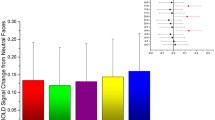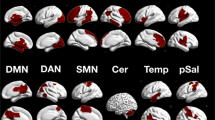Abstract
In facial expression perception, a distributed network is activated according to stimulus context. We proposed that an interaction between brain activation and stimulus context in response to facial expressions could signify a pattern of interactivity across the whole brain network beyond the face processing network. Functional magnetic resonance imaging data were acquired for 19 young healthy subjects who were exposed to either emotionally neutral or negative facial expressions. We constructed group-wise functional brain networks for 12 face processing areas [bilateral inferior occipital gyri (IOG), fusiform gyri (FG), superior temporal sulci (STS), amygdalae (AMG), inferior frontal gyri (IFG), and orbitofrontal cortices (OFC)] and for 73 whole brain areas, based on partial correlation of mean activation across subjects. We compared the topological properties of the networks with respect to functional distance-based measures, global and local efficiency, between the two types of face stimulus. In both face processing and whole brain networks, global efficiency was lower and local efficiency was higher for negative faces relative to neutral faces, indicating that network topology differed according to stimulus context. Particularly in the face processing network, emotion-induced changes in network topology were attributable to interactions between core (bilateral IOG, FG, and STS) and extended (bilateral AMG, IFG, and OFC) systems. These results suggest that changes in brain activation patterns in response to emotional face stimuli could be revealed as changes in the topological properties of functional brain networks for the whole brain as well as for face processing areas.




Similar content being viewed by others
References
Avidan G, Hasson U, Malach R, Behrmann M (2005) Detailed exploration of face-related processing in congenital prosopagnosia: 2. Functional neuroimaging findings. J Cogn Neurosci 17:1150–1167. doi:10.1162/0898929054475145
Bassett DS, Bullmore E (2006) Small-world brain networks. Neuroscientist 12:512–523. doi:10.1177/1073858406293182
Bullmore E, Sporns O (2009) Complex brain networks: graph theoretical analysis of structural and functional systems. Nat Rev Neurosci 10:186–198. doi:10.1038/nrn2575
Courtney SM, Ungerleider LG, Keil K, Haxby JV (1996) Object and spatial visual working memory activate separate neural systems in human cortex. Cereb Cortex 6:39–49. doi:10.1093/cercor/6.1.39
de Marco G, de Bonis M, Vrignaud P, Henry-Feugeas MC, Peretti I (2006) Changes in effective connectivity during incidental and intentional perception of fearful faces. Neuroimage 30:1030–1037. doi:10.1016/j.neuroimage.2005.10.001
Dima D, Stephan KE, Roiser JP, Friston KJ, Frangou S (2011) Effective connectivity during processing of facial affect: evidence for multiple parallel pathways. J Neurosci 31:14378–14385. doi:10.1523/JNEUROSCI.2400-11.2011
Dwyer DB et al (2014) Large-scale brain network dynamics supporting adolescent cognitive control. J Neurosci 34:14096–14107. doi:10.1523/JNEUROSCI.1634-14.2014
Fairhall SL, Ishai A (2007) Effective connectivity within the distributed cortical network for face perception. Cereb Cortex 17:2400–2406. doi:10.1093/cercor/bhl148
Fallani FDV, Richiardi J, Chavez M, Achard S (2014) Graph analysis of functional brain networks: practical issues in translational neuroscience. Philos Trans R Soc Lond B 369:20130521. doi:10.1098/rstb.2013.0521
Foley E, Rippon G, Thai NJ, Longe O, Senior C (2012) Dynamic facial expressions evoke distinct activation in the face perception network: a connectivity analysis study. J Cogn Neurosci 24:507–520. doi:10.1162/jocn_a_00120
Grill-Spector K, Knouf N, Kanwisher N (2004) The fusiform face area subserves face perception, not generic within-category identification. Nat Neurosci 7:555–562. doi:10.1038/nn1224
Haxby JV et al (1991) Dissociation of object and spatial visual processing pathways in human extrastriate cortex. Proc Natl Acad Sci U S A 88:1621–1625
Haxby JV, Ungerleider LG, Clark VP, Schouten JL, Hoffman EA, Martin A (1999) The effect of face inversion on activity in human neural systems for face and object perception. Neuron 22:189–199. doi:10.1016/S0896-6273(00)80690-X
Haxby JV, Hoffman EA, Gobbini MI (2000) The distributed human neural system for face perception. Trends Cogn Sci 4:223–233. doi:10.1016/S1364-6613(00)01482-0
Haxby JV, Hoffman EA, Gobbini MI (2002) Human neural systems for face recognition and social communication. Biol Psychiatr 51:59–67. doi:10.1016/S0006-3223(01)01330-0
Herrington JD, Taylor JM, Grupe DW, Curby KM, Schultz RT (2011) Bidirectional communication between amygdala and fusiform gyrus during facial recognition. Neuroimage 56:2348–2355. doi:10.1016/j.neuroimage.2011.03.072
Holmes AP, Blair R, Watson G, Ford I (1996) Nonparametric analysis of statistic images from functional mapping experiments. J Cereb Blood Flow Metab 16:7–22. doi:10.1097/00004647-199601000-00002
Ishai A (2008) Let’s face it: it’s a cortical network. Neuroimage 40:415–419. doi:10.1016/j.neuroimage.2007.10.040
Ishai A, Schmidt CF, Boesiger P (2005) Face perception is mediated by a distributed cortical network. Brain Res Bull 67:87–93. doi:10.1016/j.brainresbull.2005.05.027
Kanwisher N, McDermott J, Chun MM (1997) The fusiform face area: a module in human extrastriate cortex specialized for face perception. J Neurosci 17:4302–4311
Kranz F, Ishai A (2006) Face perception is modulated by sexual preference. Curr Biol 16:63–68. doi:10.1016/j.cub.2005.10.070
Latora V, Marchiori M (2001) Efficient behavior of small-world networks. Phys Rev Lett 87:198701. doi:10.1103/PhysRevLett.87.198701
Lee KU, Kim J, Yeon B, Kim SH, Chae JH (2013) Development and standardization of extended ChaeLee Korean facial expressions of emotions. Psychiatr Invest 10:155–163. doi:10.4306/pi.2013.10.2.155
Lv B et al (2010) Gender consistency and difference in healthy adults revealed by cortical thickness. Neuroimage 53:373–382. doi:10.1016/j.neuroimage.2010.05.020
Okada G et al (2011) The effect of negative and positive emotionality on associative memory: an fMRI study. PLoS One 6:e24862. doi:10.1371/journal.pone.0024862
Park CH et al (2014) Affective state-dependent changes in the brain functional network in major depressive disorder. Soc Cogn Affect Neurosci 9:1404–1412. doi:10.1093/scan/nst126
Rossion B, Caldara R, Seghier M, Schuller AM, Lazeyras F, Mayer E (2003) A network of occipito-temporal face-sensitive areas besides the right middle fusiform gyrus is necessary for normal face processing. Brain 126:2381–2395. doi:10.1093/brain/awg241
Schäfer J, Strimmer K (2005) A shrinkage approach to large-scale covariance matrix estimation and implications for functional genomics. Stat Appl Genet Mol Biol 4:1–30. doi:10.2202/1544-6115.1175
Sergent J, Ohta S, MacDonald B (1992) Functional neuroanatomy of face and object processing. A positron emission tomography study. Brain 115:15–36. doi:10.1093/brain/115.1.15
Smith SM (2012) The future of fMRI connectivity. Neuroimage 62:1257–1266. doi:10.1016/j.neuroimage.2012.01.022
Tzourio-Mazoyer N et al (2002) Automated anatomical labeling of activations in SPM using a macroscopic anatomical parcellation of the MNI MRI single-subject brain. Neuroimage 15:273–289. doi:10.1006/nimg.2001.0978
Wang L, Metzak PD, Honer WG, Woodward TS (2010) Impaired efficiency of functional networks underlying episodic memory-for-context in schizophrenia. J Neurosci 30:13171–13179. doi:10.1523/JNEUROSCI.3514-10.2010
Zhu WL, Wen W, He Y, Xia AH, Anstey KJ, Sachdev P (2012) Changing topological patterns in normal aging using large-scale structural networks. Neurobiol Aging 33:899–913. doi:10.1016/j.neurobiolaging.2010.06.022
Acknowledgments
This research was supported by Basic Science Research Program through the National Research Foundation of Korea (NRF) funded by the Ministry of Education, Science and Technology (2012R1A1A2044932).
Author information
Authors and Affiliations
Corresponding author
Electronic supplementary material
Below is the link to the electronic supplementary material.
10548_2015_449_MOESM1_ESM.tif
Supplementary material 1 (TIFF 259 kb) Computation of (A) interregonal and (B) epiregonal efficiency for an example network N with 12 nodes. The interregional efficiency, e ab , between a pair of nodes a and b is 0.2500 as the reciprocal of the shortest path length, d ab , between them (along the path indicated in red in (A)). The global efficiency, E g(N), of the network N is computed as the average of interregional efficiency for 12 × (12-1)/2 pairs of nodes in the network. The epiregional efficiency, E(N c), of a local subnetwork N c that consists of the 5 nearest neighbours of a node c is 0.2000 as the average of interregional efficiency measured for the 5 nodes (indicated in yellow in (B)) in the local subnetwork. The local efficiency, E l(N), of the network N is computed as the average of epiregional efficiency for 12 local subnetworks in the network
10548_2015_449_MOESM2_ESM.tif
Supplementary material 2 (TIFF 200 kb) Changes in thresholds for correlation matrices, which determine the sparsity of (A) the face selective network and (B) whole brain network, for emotionally negative faces and emotionally neutral faces
10548_2015_449_MOESM3_ESM.tif
Supplementary material 3 (TIFF 1747 kb) Edges of the face processing network for which interregional efficiency differed between emotionally negative faces and emotionally neutral faces at each connection density. No difference in interregional efficiency was shown at a connection density of 0.30. Red and blue lines indicate higher and lower interregional efficiency, respectively, for emotionally negative faces relative to emotionally neutral faces
Rights and permissions
About this article
Cite this article
Park, Ch., Lee, HK., Kweon, YS. et al. Emotion-Induced Topological Changes in Functional Brain Networks. Brain Topogr 29, 108–117 (2016). https://doi.org/10.1007/s10548-015-0449-z
Received:
Accepted:
Published:
Issue Date:
DOI: https://doi.org/10.1007/s10548-015-0449-z




